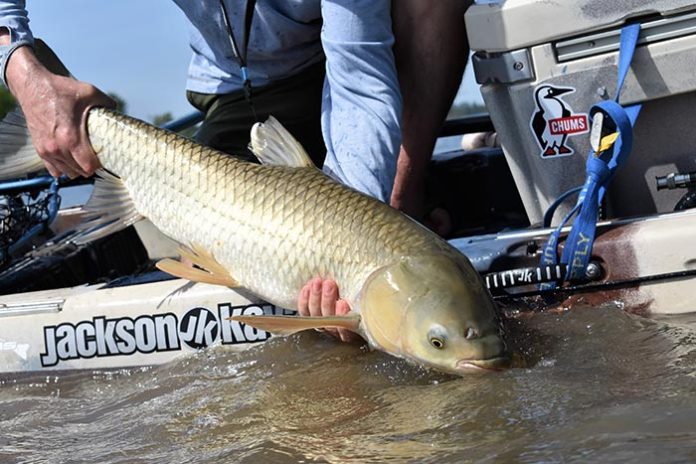Written by: Drew Ross, Looknfishy
You’ll have to learn to accept a pretty high failure rate if you want to eventually land a grass carp.
Photos by Drew Ross
Grass carp can be a challenge on the fly and frustrated me for years. My first experience was very memorable. In the summer 2012, I was working some lily pads for bass when a huge shadow crept below my popper. My heart rate elevated at the thought of the explosive take I expected. While I was choreographing the battle, the grass carp slowly sipped the popper down like a trout. I set the hook, and the carp exploded like a redfish and broke off after a few seconds. The event ended quicker than it took to read this paragraph. Although I wasn’t successful on that day, what I learned changed my perception on how they feed and ultimately how I target them. Here are some techniques that have helped me bring grassers to hand with regularity.
The most common question I get asked is, “What fly did you catch that grass carp on?” I wish it were as simple as having the right fly. It’s no secret that they spend most of their time grazing on vegetation, but I’ve learned they will also eat a verity of insects. However, the real secret is getting a fly in front of a grass carp before it sees you. In my experience, most anglers never even give themselves a chance. They spooked the fish before the fly ever touched the water.

Staying far away from your quarry is job number one.
Stealth is easily the most important consideration when it comes to getting a grass carp to take a fly. It doesn’t matter if you’re in a kayak, walking the bank, or in a boat. Once a carp is spooked, that opportunity is gone. But that’s what makes the chase so much fun. These fish are so highly sensitive to their surroundings that they’ll freak out if a butterfly passes over them. My advice for concealing your presence is to eliminate all noise, both above and below the water.
Wear clothing that blends into your surroundings. While I’m an advocate for wearing bright colors on the water for safety, looking like a road cone will also help grass carp to avoid you. Another thing to consider is that they pick up quick movements very well and react to them in sheer panic. I try to avoid witnessing such behavior by doing my best to move slowly and deliberately. This is not the time to adjust your buff or check your Facebook page. Lastly, avoid placing your or your rod’s shadow over the carp.

Once hook, grassers put up a tackle-testing fight, and getting one to the net isn’t easy.
Last weekend, I was in my kayak chasing grassers with two friends who were in a raft. I was on a flat in sight of several fish when I heard their paddle splash about 50 yards behind me. It wasn’t obnoxious, but it was enough to alert the fish. When they got to the flat, all that remained were mud trails. Noises like paddle splash, trolling motor vibration, and dropping things onto the deck of the boat alert these fish. The noise you send into the water will betray you long before you’re in range.
Obviously with such skittish targets, sight casting is a must. Keep in mind that grass carp are not ambush predators and typically won’t case down a meal. But they won’t pass up an easy one, either. A well-presented fly has about a 25 percent chance of getting eaten and a 75 percent chance of freaking out the fish. That’s just the game. I don’t have much success if my fly lands outside the fish’s “dinner plate” area, and dragging a fly into view never works. Grassers just don’t like to see things moving around them. A fly slowly falling through the water seems to elicit a better response. A proven technique is placing a small leech in the zone. I tie leeches with a foam body and head so that the fly floats for a second before sinking slowly. The good news is that it only takes a moment to know if the fish are interested. If you see a cloud of mud, move on to the next target.

When you see tailing carp, your eyes should light up because your odds just increased.
With all that said, there are some clues that you can recognize to improve your chances of success. The first thing is to look for aggressive behavior and eliminate the carp that won’t eat. In life, there are situations that no matter how hard you work or what you do, you have ZERO chance of being successful. Search for carp that are in the right mood and move past the ones that only offer rejection. Here are some things to look for:
- Tailing: When you see fsh feeding on the bottom, with their tail out of the water, you can get excited. Tailing grassers are readily approachable because they’re focused on the bottom and have their force fields dialed down.
- Cruising: When you see fish flashing or porpoising in the distance. These carp are active and stimulated. But don’t confuse this with fleeing behavior. When a large group of grass carp are spotted moving in the same direction, away from your general direction, they’ve decided they don’t like you. In my experience, they are on guard and grouped for protection. Pack up and find new water.
- Feeding: Obviously if you see a grasser eat something–a bee, wasp, or mayfly–go that way fast! Feeding carp are aggressive and seem oblivious to their surroundings. This is a great opportunity to get a fly in front of a grass carp without the usual challenge of a delicate presentation. They’ve already decided to eat, and all that’s required now is your getting a fly in front of one. This is one of the rare times when I’ll give my fly some action to draw some attention.

When you do everything right–and the fish are in the mood–the payoff is gratifying.
Grass carp are an exciting challenge. They require an approach and finesse more commonly associated with finicky trout, but the have the power and fight of some inshore species. It’s still a game of rejection and frustration, but one that will make you a better fly angler. I’m not an expert and am still actively learning, but these techniques and behaviors have helped me, and I hope they help you.
Drew Ross writes the Looknfishy blog. Check out his Facebook page for more great photos.
Credit: Source link































